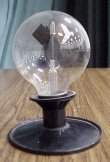Radiometer

PIRA 4D20.10
The Radiometer shown at right is partially evacuated. When exposed to bright light, the black sides of each fin get warmer than the white sides. Gas molecules leaving the black sides after a collision or adsorption will have a larger average speed than those leaving the white sides, and so will transfer more momentum to the fins. As a result the fins will spin clockwise when viewed from above.
If you are truly evil, this is a good demo to do right after a discussion of the momentum carried by photons.
If you place the Radiometer next to a large block of dry ice, the fins will rotate counter-clockwise when viewed from above as it cools. The black sides will radiate heat away more quickly, and so will be colder than the white sides for a brief period. You can also first heat the Radiometer with a hair dryer and then allow it to cool.
This explanation is a simplification of the processes occurring in the radiometer. The interactions causing the vanes to move occur near the edges of the vanes, on the order of the mean free path away from the edges. A fascinating discussion of the mechanisms driving the radiometer's motion and the history of their discovery can be found in "The Radiometer and How it Does Not Work" by Arther E. Woodruff in The Physics Teacher 6, 358-363 (1968).
